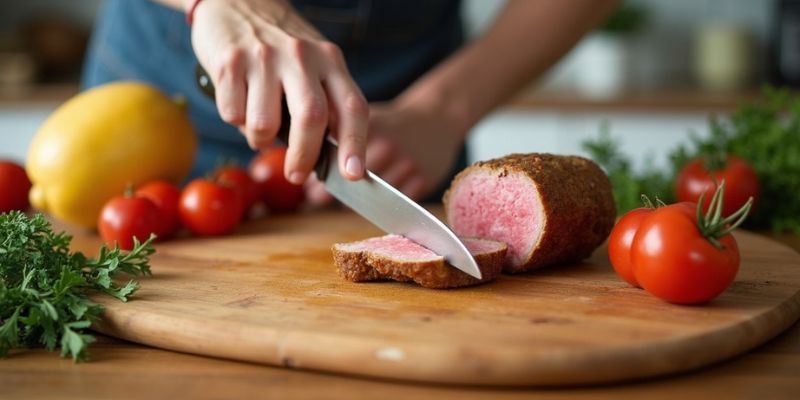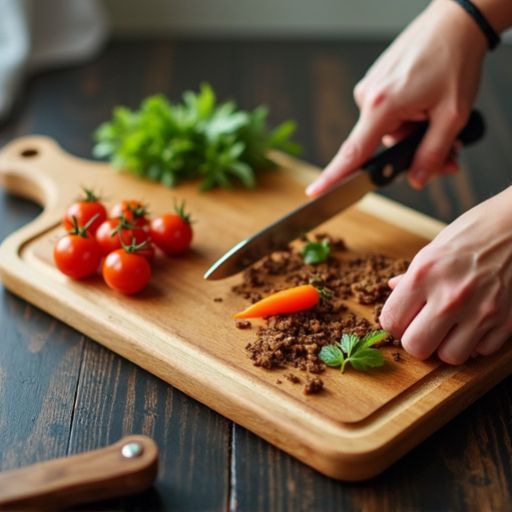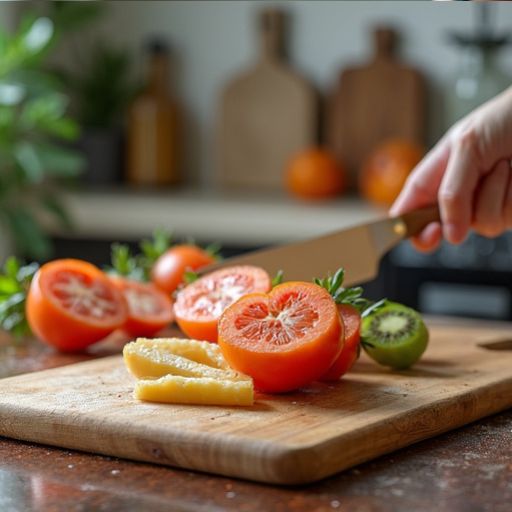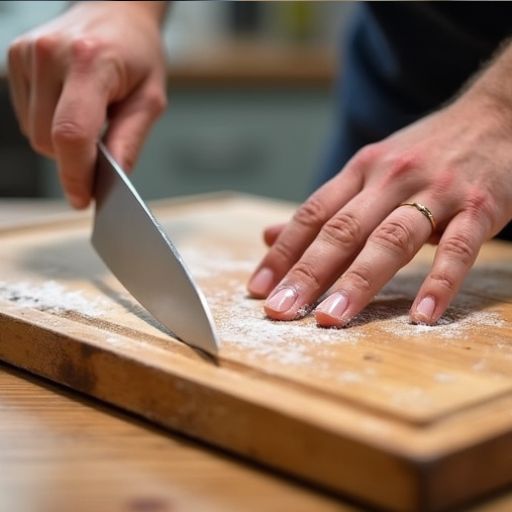11 Ways Your Cutting Board Could Be Making You Sick (Health Alert #4!)
Your cutting board chops, dices, and serves as the foundation for meal prep, but it might also be harboring dangerous bacteria that could make you sick.
While you’re focused on creating delicious dishes, microscopic pathogens could be multiplying in plain sight on this essential kitchen tool.
From cross-contamination to improper sanitization, several common mistakes can transform your trusty cutting board into an unexpected health hazard.
Before you prepare your next meal, you’ll want to know about these eleven vital ways your cutting board might be compromising your family’s health—and what to do about them.

Not Sanitizing After Raw Meat
After handling raw meat on a cutting board, failing to properly sanitize the surface creates an ideal environment for dangerous bacterial growth.
Raw meat leaves behind pathogenic bacteria like E. coli, Salmonella, and Campylobacter that can multiply rapidly at room temperature.
You’ll need more than just soap and water to eliminate these threats.
Studies show that a solution of 1 tablespoon of bleach per gallon of water effectively kills 99.9% of harmful bacteria.
After cleaning with hot, soapy water, apply this sanitizing solution and let it sit for at least 1 minute.
You’re putting yourself at risk if you skip this essential step – research indicates that contaminated cutting boards can harbor live bacteria for up to 48 hours.
Cross-contamination can occur when you later use the board for ready-to-eat foods.
Using One Board For Everything

Proper sanitization becomes meaningless if you’re using the same cutting board for all your food preparation tasks.
Cross-contamination occurs when bacteria from raw meat transfer to ready-to-eat foods like vegetables or fruits, potentially causing severe foodborne illness.
You’ll need at least two separate cutting boards: one exclusively for raw meat, poultry, and seafood, and another for produce and ready-to-eat foods.
Studies show that even after washing, cutting boards can harbor dangerous pathogens like E. coli and Salmonella in their microscopic grooves.
These bacteria can survive for hours or even days, making cross-contamination a significant risk.
Consider using color-coded boards – red for raw meat, green for vegetables – to maintain clear separation.
This system helps prevent accidental mix-ups during busy meal prep sessions and keeps your food preparation consistently safe.
Ignoring Deep Knife Grooves
Countless home cooks overlook the dangers of deep knife grooves in their cutting boards, creating perfect breeding grounds for harmful bacteria.
When you repeatedly slice and chop in the same spots, you’re carving out microscopic valleys that trap food particles, moisture, and microorganisms.
These grooves aren’t just cosmetic problems – they’re potential health hazards.
Studies show that deep cuts in wooden and plastic boards can harbor E. coli, Salmonella, and other pathogens that survive even after washing.
You’ll need to sand wooden boards or replace plastic ones once the grooves become pronounced.
A simple test: if you can feel the grooves with your fingernail, it’s time to take action.
Don’t risk your health by continuing to use a deeply scarred board that’s impossible to sanitize properly.
Storing Boards While Still Wet

Deep grooves aren’t the only way moisture can compromise your cutting board’s safety – storing boards while they’re still wet creates an equally dangerous situation.
When you stack damp boards in cabinets or drawers, you’re creating an ideal environment for bacterial growth, mold, and mildew to thrive.
These microorganisms multiply rapidly in dark, moist conditions.
You’ll need to thoroughly dry your cutting boards after each washing, preferably standing them vertically to allow air circulation on both sides.
Even a seemingly dry surface can harbor hidden moisture that’s been absorbed into the board’s material.
If you’re using wooden boards, this trapped moisture won’t just promote bacterial growth – it’ll also cause warping and splitting, creating new crevices where harmful pathogens can hide.
Don’t risk your health by rushing the drying process.
Washing With Warm Water Only
Many home cooks make the critical mistake of cleaning their cutting boards with warm water alone, failing to eliminate dangerous foodborne pathogens.
While warm water can remove visible food particles, it’s insufficient to kill bacteria like E. coli, Salmonella, and Listeria that commonly contaminate cutting surfaces.
You’ll need to sanitize your board properly with either a solution of 1 tablespoon of unscented chlorine bleach per gallon of water or white vinegar at full strength.
Let the sanitizing solution sit on the board for several minutes before rinsing.
Hot water (at least 140°F) combined with soap is also essential for breaking down meat proteins and fat residues that harbor bacteria.
Don’t forget to scrub both sides of the board, even if you’ve only used one surface, as bacteria can migrate through the material’s pores.
Wrong Cleaning Products

While proper sanitizing techniques are essential, using incorrect cleaning products can be just as hazardous as insufficient cleaning.
Strong detergents, bleach solutions that are too concentrated, and harsh chemical cleaners can seep into your cutting board’s surface, creating toxic residues that transfer to your food.
You’ll want to avoid commercial cleaning products containing ammonia, triclosan, or quaternary compounds, as these chemicals can leach into your foods, especially acidic ones.
Instead, opt for food-safe sanitizers like diluted white vinegar (one part vinegar to four parts water) or a mild solution of one tablespoon of unscented bleach per gallon of water.
You’re better off using natural alternatives that won’t compromise your health or damage your cutting board’s surface over time.
Keeping Old Worn-Out Boards
Using old, worn-out cutting boards can pose serious health risks due to their compromised surfaces.
Deep knife scratches, cracks, and warped areas create perfect hiding spots for harmful bacteria like E. coli and Salmonella to thrive, even after washing.
These microscopic crevices can trap food particles and moisture, creating an ideal breeding ground for pathogens.
You’ll know it’s time to replace your cutting board when you notice deep gouges that your fingernail can catch on, stains that won’t come out, or a surface that’s become rough and porous.
If your wooden board has split or your plastic board has deep discoloration, you’re putting yourself at risk.
Don’t let budget concerns keep you from replacing a worn board – the potential cost of foodborne illness far outweighs the price of a new cutting board.
Cross-Contaminating Raw and Cooked Foods

Cross-contamination regularly occurs when the same cutting board is used for both raw meats and ready-to-eat foods without proper sanitization between uses.
When you cut raw chicken on your board, dangerous bacteria like Salmonella and Campylobacter can survive on the surface for hours, transferring to vegetables or bread you slice later.
You’ll need separate cutting boards – one exclusively for raw meats and another for produce and ready-to-eat items.
If you’re working with only one board, you must sanitize it thoroughly between uses: wash with hot soapy water, rinse well, then sanitize with a solution of 1 tablespoon bleach per gallon of water.
Let it air dry completely.
Even microscopic amounts of raw meat juice can contain enough bacteria to cause foodborne illness, so don’t take shortcuts with this critical safety step.
Improper Board Material Selection
Beyond proper sanitization practices, the material of your cutting board plays a major role in food safety.
Low-quality plastic boards can harbor bacteria in their deep knife scratches, while cheap wooden boards may splinter and contaminate your food.
You’ll need to choose materials that resist bacterial growth and maintain structural integrity.
Hardwoods like maple, beech, and oak contain natural antimicrobial properties and self-healing fibers that help prevent deep gouging.
If you’re opting for plastic, select commercial-grade polyethylene or polypropylene that’s FDA-approved for food contact.
Glass and bamboo boards aren’t ideal choices – glass dulls knives and can shatter, while bamboo’s high silica content damages blade edges and its glues may contain harmful chemicals.
Your safest bet is investing in either high-grade hardwood or professional-quality plastic cutting boards.
Skipping Weekly Deep Cleaning

While daily cleaning helps prevent immediate contamination, failing to perform weekly deep cleaning of your cutting board can lead to dangerous bacterial buildup in microscopic crevices.
Even boards that appear clean can harbor E. coli, Salmonella, and Listeria in these tiny grooves, especially after repeated knife cuts create more hiding spots for pathogens.
A weekly deep clean isn’t optional – it’s your defense against foodborne illness.
You’ll need to scrub with hot water and soap, then disinfect with either a bleach solution (1 tablespoon per gallon of water) or white vinegar.
Let the solution sit for 5 minutes, rinse thoroughly, and air dry completely.
For wooden boards, you’ll also need to apply food-grade mineral oil after drying to prevent warping and cracking that can create additional bacterial havens.
Poor Board Storage Practices
Even with proper cleaning protocols in place, improper storage of cutting boards can quickly undo your sanitation efforts.
Storing boards while they’re still damp creates an ideal breeding ground for bacteria, mold, and fungi, which thrive in moist environments between 40-140°F.
You’ll want to store your cutting boards vertically in a well-ventilated area, allowing air to circulate freely around all surfaces.
Don’t stack wet boards together or lay them flat against counter surfaces where moisture can become trapped.
If you’re short on space, install a simple rack or use a dish-drying rack temporarily until boards are completely dry.
Avoid storing boards near heat sources or in areas prone to temperature fluctuations, as these conditions can cause warping and create microscopic cracks where bacteria hide.
FAQs
How Long Should I Soak My Cutting Board in Bleach Solution?
You’ll want to soak your cutting board in a solution of 1 tablespoon bleach per gallon of water for 2 minutes. Then rinse thoroughly with clean water and let it air dry completely.
Can I Use My Cutting Board as a Serving Platter?
Research shows 99% of bacteria can transfer between surfaces in 30 seconds. While you’re free to serve on your cutting board, you shouldn’t use one that’s been exposed to raw meat or poultry.
What’s the Ideal Thickness for a Wooden Cutting Board?
You’ll want your wooden cutting board to be 1.5 to 2 inches thick. This provides ideal stability, prevents warping, and absorbs knife impact well. Thinner boards can split, while thicker ones are unnecessarily heavy.
Do Bamboo Cutting Boards Need Special Mineral Oil Treatments?
Like a thirsty plant seeking water, your bamboo board needs mineral oil treatment every 2-3 months. You’ll want to apply it generously since bamboo’s dense fibers absorb less oil than traditional hardwoods.
How Many Cutting Boards Should a Typical Home Kitchen Have?
You’ll need at least two cutting boards: one for raw meat/poultry/seafood and another for produce/bread. For ideal food safety and convenience, you might want a third for strong-flavored items like onions and garlic.
Final Thoughts
You’ll greatly reduce your risk of foodborne illness by implementing proper cutting board hygiene practices.
While you might think a quick rinse is sufficient, research shows that 70% of household cutting boards harbor harmful bacteria even after basic washing.
Using separate boards for raw meat and produce, sanitizing with a bleach solution (1 tablespoon per gallon), and allowing complete air-drying creates multiple barriers against pathogen survival.